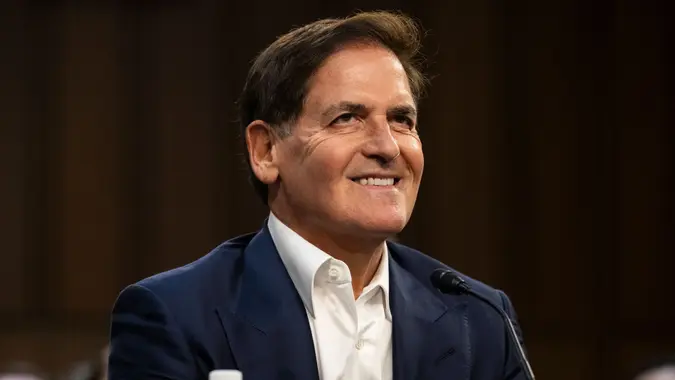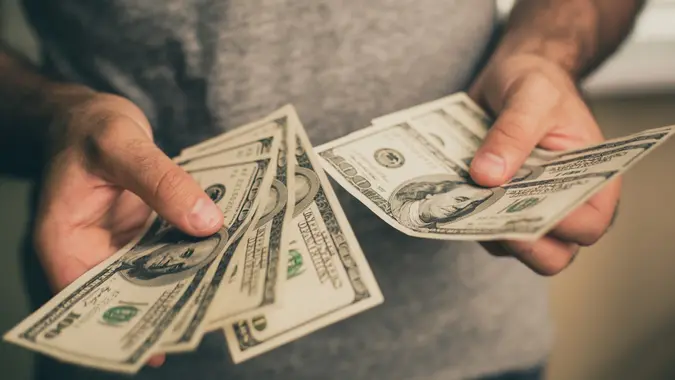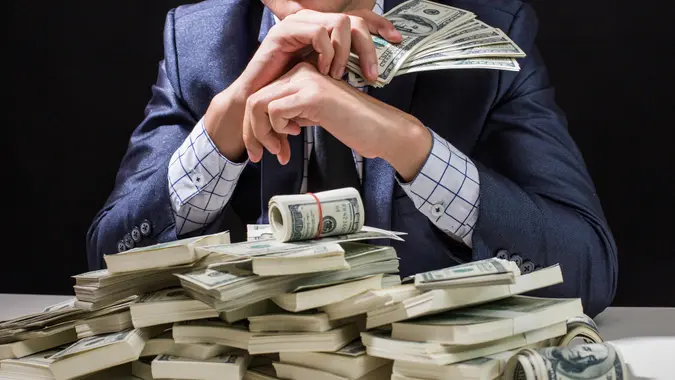Did Stimulus Checks Cause High Inflation? The Answer May Surprise You

Commitment to Our Readers
GOBankingRates' editorial team is committed to bringing you unbiased reviews and information. We use data-driven methodologies to evaluate financial products and services - our reviews and ratings are not influenced by advertisers. You can read more about our editorial guidelines and our products and services review methodology.

20 Years
Helping You Live Richer

Reviewed
by Experts

Trusted by
Millions of Readers
America stayed afloat during the pandemic thanks to a $5 trillion avalanche of money transferred from the government back to the people during 2020-21. The biggest share, according to The New York Times, was paid directly to households and businesses.
To date, spanning three installments, more than 476 million payments totaling $814 billion in financial aid have gone out in stimulus relief payments. In fact, more than $1 trillion made its way into personal bank accounts through direct stimulus payments and advance Child Tax Credits alone. Trillions more reached them indirectly through enhancements to programs like SNAP.
While in 2025, there is no plan for more stimulus payments, there is still a window of opportunity if you haven’t received a payment you were owed from the 2019 or 2018 tax year. If this applies to you, you can file for these payments in the form of a Recovery Rebate Credit if you file by April 15, 2025.
Whether you received a stimulus check or not, you definitely would have noticed that prices soon began increasing across the entire economy, and not long after, inflation was rising at a rapid rate. It’s easy to draw a straight cause-and-effect line between the two events, but the connection between today’s high inflation and the largest cash injection in America’s economic history is a bit more complicated than that.
Here are a few ways stimulus checks could have fueled inflation, but not all of it.
Economic Expansion
Inflation is a normal and natural side effect of economic expansion. As businesses grow, they hire more workers, unemployment falls and households have more money to spend, so demand for goods and services increases, which causes prices to rise.
The economic impact of the pandemic and stimulus payments, however, was neither normal nor natural. And it stands to reason that a sudden influx of trillions of stimulus dollars would send prices up quickly.
Now, with the greater implications of the pandemic largely behind America, the economy is trending toward normal expansion. Prices are rising more slowly, and inflation has cooled to 2.8%. On the other hand, with certain impending tariffs under the Trump administration, inflation could once again accelerate.
So, are the stimulus payments to blame for today’s high inflation, as some voices on the politically toxic subject would have you believe? There’s no question that the payments are responsible for at least a few percentage points of the spike.
Consumer Demand, War and Labor Shortages
Despite all the controversy, economists generally agree on some of the causes behind the high inflation that has defined the economy over the last several years:
- The pandemic shifted consumer demand away from services toward goods, which left producers unable to keep up with demand.
- Factory closures from early in the pandemic reduced supply just as demand was rising, which sent prices up even further.
- Russia’s invasion of Ukraine caused a spike in oil prices, which increased the cost of both manufacturing and shipping, while also forcing up the price of wheat and other commodities.
On top of that, the U.S. was dealing with a labor shortage, leaving many businesses that had been shuttered for months unable to meet rising demand — much of which was due to stimulus payments — when they were finally able to open.
Though that shortage has slightly rebounded now in 2025, it’s nowhere near the numbers it had in certain industries such as hospitality pre-pandemic.
America’s Stimulus Money vs. Rest of the World
Those who draw a straight line between stimulus payments and generationally high inflation have two indisputable facts on their side:
- No country distributed anywhere near as much stimulus money to its people as the United States
- No country was hit as hard by rising inflation as the United States
That’s as close to a smoking gun as stimulus opponents could ever hope for, but it’s also a simplification. High inflation has been a worldwide phenomenon — but stimulus payments were not. Other countries that reacted to the virus with comparatively passive monetary policies suffered from similarly high inflation.
Final Take To GO: It Was the Worst of Times, It Was the Worst of Times
The bottom line is that the question remains — can a huge injection of cash into the economy cause prices to rise? You bet.
According to the International Monetary Fund (IMF), “If the money supply grows too big relative to the size of an economy, the unit value of the currency diminishes; in other words, its purchasing power falls and prices rise.”
That describes the quantity theory of money, which is among the oldest and most primary economic concepts — but it’s not the only game in town.
The IMF elaborates with this: “Supply shocks that disrupt production, such as natural disasters, or raise production costs, such as high oil prices, can reduce overall supply and lead to ‘cost-push’ inflation, in which the impetus for price increases comes from a disruption to supply.”
Did stimulus checks distributed over the last few years cause inflation? Not exactly — but they certainly played a role.
John Csiszar and Andrew Lisa contributed to the reporting for this article.
 Written by
Written by  Edited by
Edited by 

























